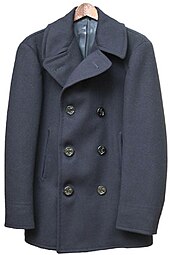1960s Boy Fashion Pea Coat 1960s Boy Fashion

Military surplus coat, produced for the US Navy
A pea coat (or peacoat, pea jacket, pilot jacket, reefer jacket) is an outer coat, more often than not of a navy-coloured heavy wool,[1] originally worn by sailors of European and later American navies.[2] Pea coats are characterized by brusque length, wide lapels, double-breasted fronts, frequently large wooden, metal or plastic buttons, three or four in 2 rows, and vertical or slash pockets.[iii] References to the pea jacket announced in American newspapers at least as early as the 1720s,[4] and modern renditions still maintain the original design and limerick.[1]
A "bridge coat" is a pea coat that extends to the thighs, and is a compatible exclusively for officers and chief petty officers. The reefer jacket is for officers[5] [ failed verification ] and principal petty officers simply, and is identical to the basic design, but unremarkably has golden buttons and epaulettes. Only officers wearable the epaulettes.[2]
Characteristics [edit]
Today, the style is considered a classic, and pea coats are worn by all manner of individuals. The mode has evolved to the addition of hoods.
While some of the jackets seen on the street are genuine navy surplus, most are designs inspired past the classic uniform and available from retailers with blueprint variations that reflect electric current fashion trends, including a variety of fabrics and colours. The standard Us Navy-issued pea coat uses night blue or black wool and sports buttons (originally in brass and afterward black plastic) decorated with an anchor motif. The standard fabric for historical pea coats in the 20th century was a smooth and heavy, night navy blue Kersey wool, which was dense enough to repel wind and pelting, and able to incorporate body heat without farther insulation. This wool was left lightly treated after being sheared to retain much of the natural lanolin oil from sheep, thus increasing its water-repelling and insulating backdrop.[vi] [seven] Kersey was gradually replaced in the U.S. Navy through the 1970s past the rougher black Melton material (besides lightly treated), a lighter wool that requires a quilted lining to friction match the warmth of the original Kersey.[8]

A black leather version of the reefer jacket was worn by Kriegsmarine U-gunkhole officers during Earth State of war Ii, including Admiral Dönitz.[nine] It was as well worn with a peaked cap by Red Army commissars,[10] tank commanders, and pilots.[xi]
Etymology [edit]
According to a 1975 edition of The Mariner'due south Mirror, the term "pea glaze" originated from the Dutch or West Western frisian word pijjekker or pijjakker, in which pij referred to the blazon of fabric used, a coarse kind of twilled blue cloth with a nap on one side. Jakker designates a man's short, heavy coat.[12]
Another theory, favoured by the US Navy, is that the heavy topcoat worn in cold, miserable weather by seafaring men was one time tailored from "airplane pilot cloth" — a heavy, coarse, stout kind of twilled blue cloth with the nap on one side. This was sometimes called P-cloth from the initial letter of pilot, and the garment made from it was called a P-jacket — after a pea coat. The term has been used since 1723 to denote coats made from that textile.[thirteen]
See also [edit]
- Chesterfield coat
- Covert coat
- Duffle coat
- Greatcoat
- Paletot
- Polo coat
- Trench glaze
References [edit]
- ^ a b "US Navy-way Pea ("P") Coat". United states of america Wings Inc. 2008. Archived from the original on 2007-10-17. Retrieved 2007-12-31 .
- ^ a b Josh Williams (2013). "The History of the Pea Coat". Tails . Retrieved 2014-01-07 .
- ^ Stilson, Sam (2007). "The Perfection Of The Pea Coat". The Soko . Retrieved 2007-12-31 .
- ^ Boston Gazette, Iss. 22, May 9–16, 1720, p.three
- ^ "What is a Reefer Jacket?". 2015-04-22. Retrieved 2019-11-eleven .
- ^ "Waterproofing a wool glaze".
- ^ "PEACOAT DATING". The Fedora Lounge . Retrieved 2021-09-27 .
- ^ Hoyt, Edwin P. (March iv, 2002). The U-Boat Wars. Cooper Square Press. ISBN9781461661306 – via Google Books.
- ^ Stites, Richard (November fourteen, 1991). Revolutionary Dreams: Utopian Vision and Experimental Life in the Russian Revolution. Oxford University Press. ISBN9780199878956 – via Google Books.
- ^ Chamberlin, William Henry (July xiv, 2014). The Russian Revolution, Book 2: 1918–1921: From the Ceremonious War to the Consolidation of Ability. Princeton University Printing. ISBN9781400858705 – via Google Books.
- ^ Leonard George Carr Laughton; Roger Charles Anderson; William Gordon Perrin (1975). "The Mariner's Mirror". The Mariner'due south Mirror. 61: 26.
- ^ Origin of Navy Terminology, LT John W. Alexander, Managing director, Navy Internal Relations Action, Role of the Chief of Information
{{citation}}: CS1 maint: others (link)
External links [edit]
-
 Media related to Pea coat at Wikimedia Commons
Media related to Pea coat at Wikimedia Commons




0 Response to "1960s Boy Fashion Pea Coat 1960s Boy Fashion"
Post a Comment